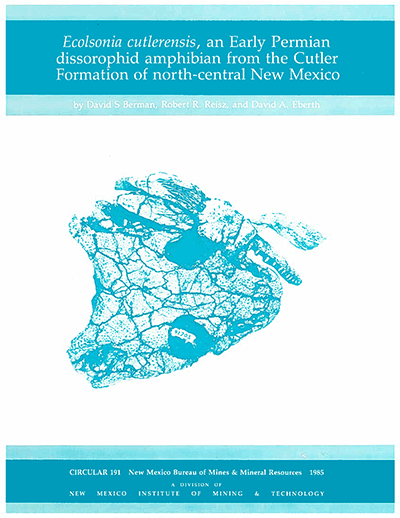
Circular 191—Ecolsonia Cutlerensis, an early Permian Dissorophid amphibian from the Cutler Formation of north-central New Mexico
By D. S. Berman, R. R. Reisz, and D. A. Eberth, 1985, 31 pp., 14 figs.

Recently
discovered specimens of temnospondyl labyrinthodont amphibian Ecolsonia
cutlerensis (Vaughn (1969)) allow a more complete description of the
amphibian's anatomy and a reevaluation of its familial position. Discovered
from the Lower Permian (Wolfcampian) Cutler Formation of north-central NM,
E. cutlerensis was originally assigned to the Trematopsidae primarily
on the basis of its possession of an elongate external naris, a characteristic
feature of the family, yet it was also recognized as possessing features
characteristic of the Dissorophidae. Although the new materials of Ecolsonia
clearly indicate the presence of a trematopsid-like naris, numerous other
cranial features, particularly the otic notch, firmly establish its dissorophid
affinities. Ecolsonia appears to be the only non-trematopsid labyrinthodont
definitely known to possess an external naris identical to that of trematopsids.
The postcranial skeleton of Ecolsonia, on the other hand, does not
possess features that are diagnostic of either family. The absence in Ecolsonia of the highly specialized dorsal dermal "armor" that characterizes
the great majority of dissorophids is unexpected in light of its otherwise
highly advanced structural grade of organization. The probable functions
of the typical dissorophid dermal "armor," that of providing strength
and immobility to the vertebral column and protection from body-moisture
loss and from predators, are believed to have been assumed in great part
in Ecolsonia by several structures not seen in other dissorophids:
(1) greater ossification of presacral intercentra to form ring-like structures;
(2) neural spines with a pair of lateral tubercles or with bifid or nodular-like
expanded summits that very likely accomodated a greatly increased development
of the system of tendinous attachment of the dorsal axial musculature; and
(3) well-developed, sculptured osteoderms that formed a dense, armor-like
covering over much of the body. The possession by Ecolsonia of numerous
unique derived features indicates that it represents a distinct lineage
that separated from all other dissorophid lines before the Early Permian.
Further, its possession of several primitive features not seen in other
dissorophids suggests that the branching may have occurred as early as the
Middle Pennsylvanian.
$6.50
Buy
Now
Also available as a free download.
Download
| File Name | Size | Last Modified |
|---|---|---|
| Circular-191.pdf | 1.66 MB | 01/11/2021 03:43:20 PM |



